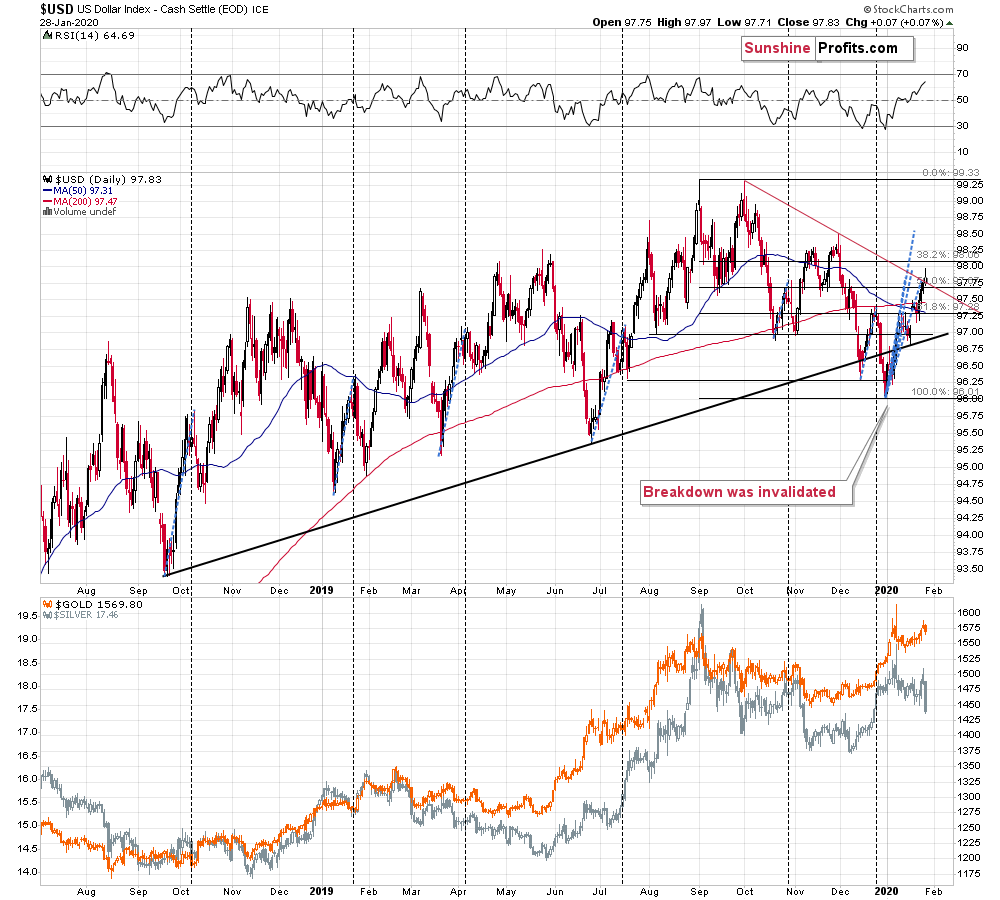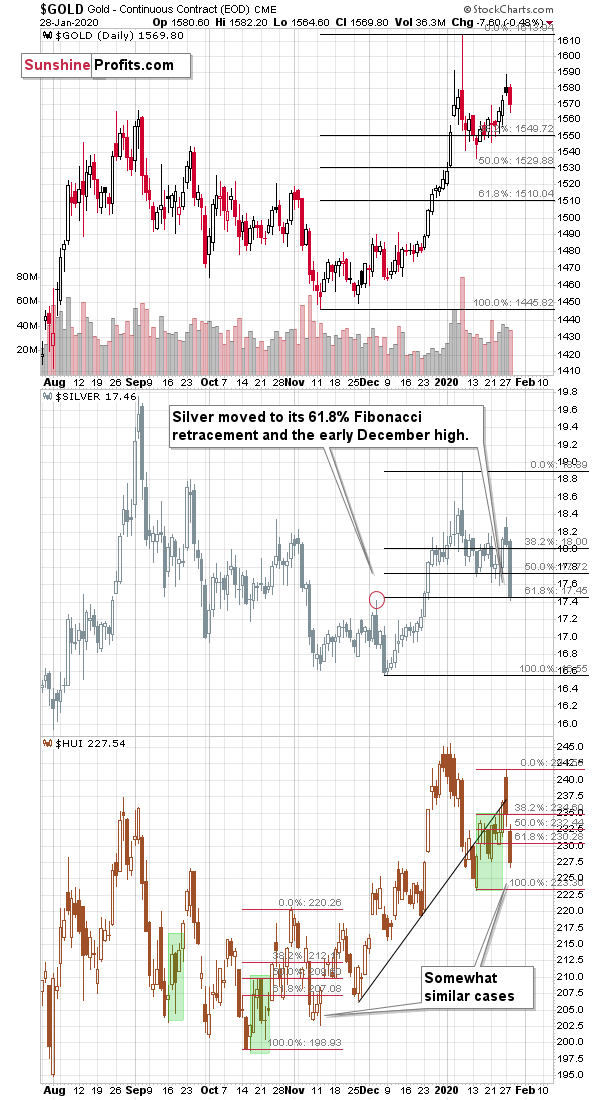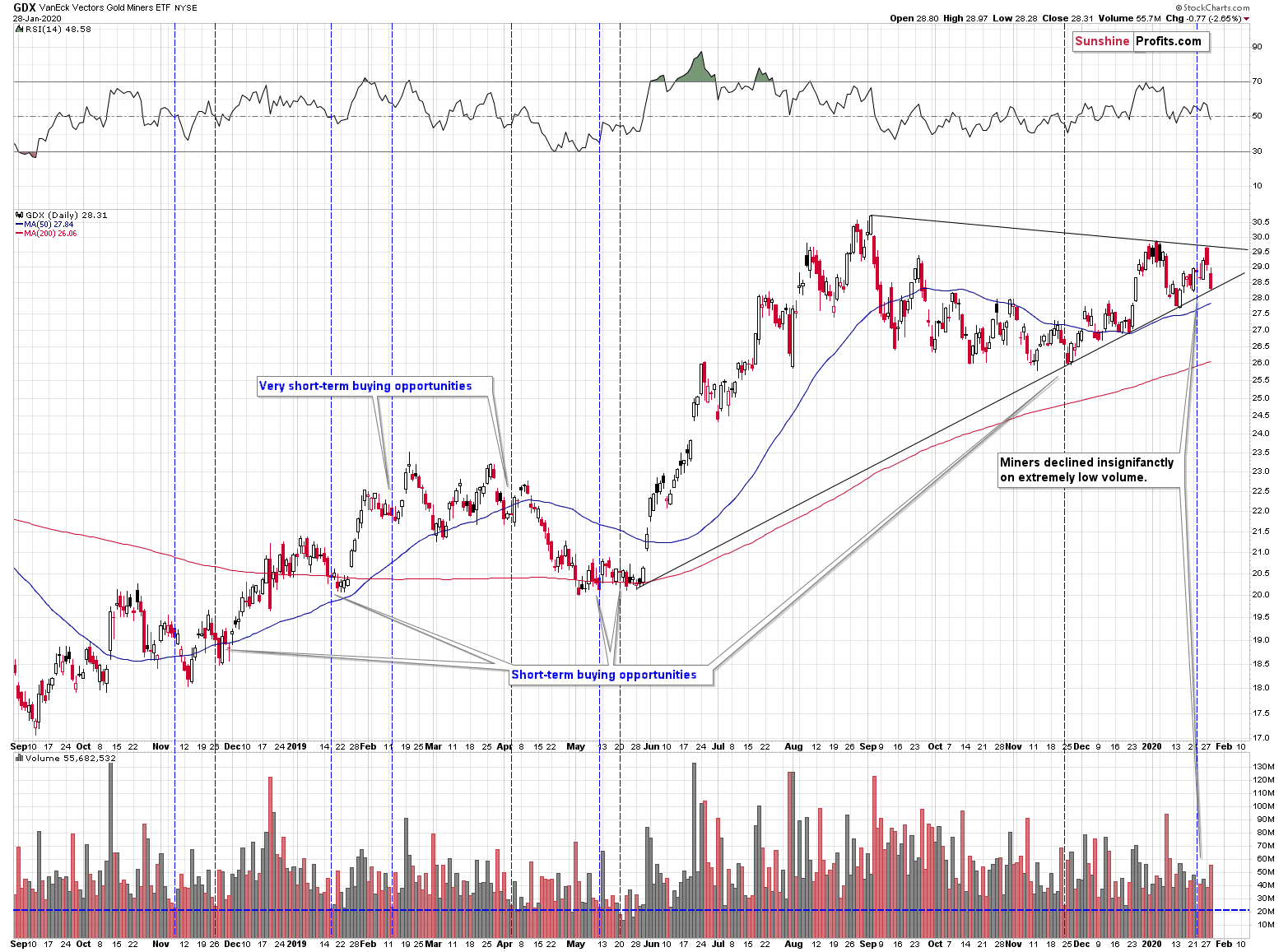Briefly: in our opinion, full speculative long position in silver is justified from the risk/reward point of view at the moment of publishing this Alert.
The precious metals sector declined sizably yesterday, but the Fed's interest rate decision is still ahead. The question arises - did we already see the top in the PMs?
In our view, we are still likely to see a rally before the truly big slide follows. Let's start with a quite likely reason that triggered the move lower in the PMs. We wrote in the past that the precious metals market tends to decline on USD's breakouts and that it tends to rally on USD's breakdowns more than the absolute USD Index price change reflects. In other words, while the PMs could ignore some USDX movement, they would be unlikely to ignore the breakouts and breakdowns.
We saw a breakout in the USD Index yesterday.
USD Index Just Made a Move
It was neither huge, nor decisive, but it did take place. The USDX rallied above the rising red resistance line and reversed before the end of the day. Still, even taking into account the late decline, it ended the session higher - above the resistance line.
Now, the important thing about this breakout is that - since it was relatively small - it would need to be confirmed if it is to really matter. Based on the sizes of the previous rallies in the USD Index and the times when it corrected (blue lines on the above chart) it seems that the USD Index is about to start a corrective decline. Even the start of the decline would likely cause the USD to invalidate its breakdown, thus giving way to a much bigger decline. Since the interest rate decision is today, it could be the spark that triggers this correction.
To be clear, we continue to think that the USD Index is headed much higher in the following months and perhaps years, but this doesn't mean that it will rally in a straight line.
The vertical dashed line on the above chart shows what happened when the USDX entered such corrective downswings in the recent past. In almost all cases, gold and silver declined (usually relatively sharply) prior to USD's declines. The July 2019 case may seem to be an exception, but it really isn't one. Back then, the USD formed two tops and the first top was indeed immediately preceded by a quick dip in both precious metals. The true exception is what happened in December 2019 - in this case gold and silver paused for a bit, before rallying again.
All in all, in most cases the quick decline in metals right at the USD top was normal. While in most cases, it is the USD Index that can tell us something about gold and silver, this time it might be the other way around first. The PMs might have declined indicating that this was indeed the final part of the USD's rally, which in turn could imply a quick comeback of the PMs along with a short-term correction in the USDX.
Yesterday in PMs
Technically, gold, silver, and mining stocks declined, but the decline didn't change as much as may seem at first sight. It was too small in gold to even consider it as meaningful. In silver, we saw a move to the 61.8% Fibonacci retracement level and the early December 2019 high and a tiny attempt to break below these levels. This attempt failed, which suggests that the situation is not as bearish as it seems.
If silver was in the current position without the likelihood of seeing a decline in the USD Index, the situation would be rather neutral for the short term right now. However, given the USDX outlook, the short-term outlook for the PMs is bullish.
The HUI Index declined far and it seems that we were correct when we wrote yesterday that miners might have already reached their top. If the precious metals market rallies from here, then we are likely to see silver outperform miners. That would likely be the final part of the short-term rally, and silver tends to strongly outperform at that stage.
Miners declined significantly, but the price level they reached is similar to what we saw in early November - miners moved well below the 61.8% Fibonacci retracement, but then invalidated this breakdown and rallied almost to their previous highs.
The GDX ETF reached its rising support line without breaking below it. That's likely to trigger another rally, just like it did in mid-December and in early January.
Summary
Summing up, it seems that the USD Index has yet to decline and thus that the rally in the precious metals sector is not over yet (it might be so for the miners, though). Silver could be very volatile in both directions and if the USDX declines, this volatility is likely to take it upwards.
Naturally, the medium-term outlook for the precious metals market remains very bearish and once the short-term correction is over, the declines are likely to resume.
As always, we'll keep you - our subscribers - informed.
To summarize:
Trading capital (supplementary part of the portfolio; our opinion): Full speculative long position (100% of the full position) in silver is justified from the risk/reward perspective with the following stop-loss orders and binding exit profit-take price levels:
- Silver futures: profit-take exit price: $18.49; stop-loss: $17.28; initial target price for the USLV ETN: $99.97; stop-loss for the USLV ETN: $82.95
Long-term capital (core part of the portfolio; our opinion): No positions (in other words: cash)
Insurance capital (core part of the portfolio; our opinion): Full position
Whether you already subscribed or not, we encourage you to find out how to make the most of our alerts and read our replies to the most common alert-and-gold-trading-related-questions.
Please note that the in the trading section we describe the situation for the day that the alert is posted. In other words, it we are writing about a speculative position, it means that it is up-to-date on the day it was posted. We are also featuring the initial target prices, so that you can decide whether keeping a position on a given day is something that is in tune with your approach (some moves are too small for medium-term traders and some might appear too big for day-traders).
Plus, you might want to read why our stop-loss orders are usually relatively far from the current price.
Please note that a full position doesn't mean using all of the capital for a given trade. You will find details on our thoughts on gold portfolio structuring in the Key Insights section on our website.
As a reminder - "initial target price" means exactly that - an "initial" one, it's not a price level at which we suggest closing positions. If this becomes the case (like it did in the previous trade) we will refer to these levels as levels of exit orders (exactly as we've done previously). Stop-loss levels, however, are naturally not "initial", but something that, in our opinion, might be entered as an order.
Since it is impossible to synchronize target prices and stop-loss levels for all the ETFs and ETNs with the main markets that we provide these levels for (gold, silver and mining stocks - the GDX ETF), the stop-loss levels and target prices for other ETNs and ETF (among other: UGLD, DGLD, USLV, DSLV, NUGT, DUST, JNUG, JDST) are provided as supplementary, and not as "final". This means that if a stop-loss or a target level is reached for any of the "additional instruments" (DGLD for instance), but not for the "main instrument" (gold in this case), we will view positions in both gold and DGLD as still open and the stop-loss for DGLD would have to be moved lower. On the other hand, if gold moves to a stop-loss level but DGLD doesn't, then we will view both positions (in gold and DGLD) as closed. In other words, since it's not possible to be 100% certain that each related instrument moves to a given level when the underlying instrument does, we can't provide levels that would be binding. The levels that we do provide are our best estimate of the levels that will correspond to the levels in the underlying assets, but it will be the underlying assets that one will need to focus on regarding the signs pointing to closing a given position or keeping it open. We might adjust the levels in the "additional instruments" without adjusting the levels in the "main instruments", which will simply mean that we have improved our estimation of these levels, not that we changed our outlook on the markets. We are already working on a tool that would update these levels on a daily basis for the most popular ETFs, ETNs and individual mining stocks.
Our preferred ways to invest in and to trade gold along with the reasoning can be found in the how to buy gold section. Additionally, our preferred ETFs and ETNs can be found in our Gold & Silver ETF Ranking.
As a reminder, Gold & Silver Trading Alerts are posted before or on each trading day (we usually post them before the opening bell, but we don't promise doing that each day). If there's anything urgent, we will send you an additional small alert before posting the main one.
Thank you.
Sincerely,
Przemyslaw Radomski, CFA
Editor-in-chief, Gold & Silver Fund Manager






